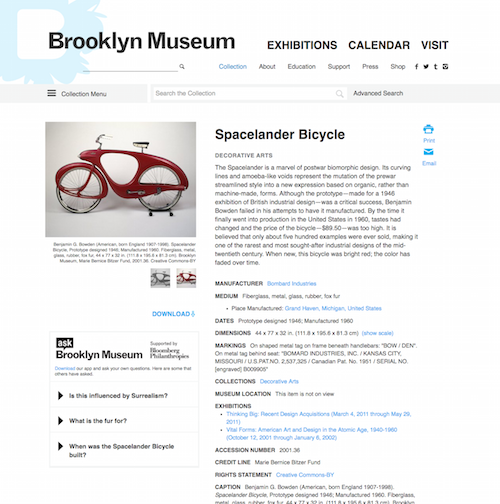ASK Snippets Integrated Into BKM Website
A number of things happen after a visitor has a chat with our ASK team. At the end of each day, the ASK team takes the long form conversations happening in the app and they break that content down into what we call “snippets.” A snippet contains a question asked by a visitor, photos that may have been taken as part of that conversation, and the answer given by the ASK team. The resulting snippet is then tagged with the object’s accession number.
So, what do we do with all these snippets of conversation? Once a snippet is tagged with an object’s accession number we use it in a number of ways internally. For starters, the snippet becomes available to the team in the dashboard ensuring the team has previous conversations at their fingertips when someone else is asking questions about the same object. Additionally, snippets are exported into Google Docs on a quarterly basis and sent to curatorial for a review. Curators review all the snippets for their collections and exhibitions, meet with the ASK team to discuss the content, and then certain snippets—those that contain the most accurate answers and are most on point with curatorial vision—are marked “curator vetted.”
These post-processing steps ensure that we can quantify how many questions have been asked and, more importantly, what questions are being asked about our objects and exhibitions. This process sees that there’s ongoing communication between the ASK team and our curatorial staff; something we’ve found critical in this project. It gives curatorial the chance to learn from the conversations taking place in our galleries every day.

ASK snippets can now be seen on object pages like in this example of our Spacelander Bicycle.
But, that’s not all. Once a snippet is marked “curator vetted,” it becomes available for various uses. Internally, we’ve developed a portal where staff can search for snippets related to objects and exhibitions. Externally, these snippets have now been integrated into the website and you’ll find them in two areas. In our collection online, you’ll see snippets related to specific objects—check out Spacelander Bicycle, Peaceable Kingdom, or Avarice for examples. Additionally, our special exhibitions now have a dedicated page of snippets related to that exhibition; you can see examples on Steve Powers, This Place, and Agitprop pages.
The beauty of this is now everyone can start to see the website immersed in the activity that’s been happening through the app and there’s a certain life that this user generated content brings to our own material. There are, of course, a myriad of ways conversational content can help shape our online presence. This is a just a start to something we hope to see grow more robust over time.

Shelley Bernstein is the former Vice Director of Digital Engagement & Technology at the Brooklyn Museum where she spearheaded digital projects with public participation at their center. In the most recent example—ASK Brooklyn Museum—visitors ask questions using their mobile devices and experts answer in real time. She organized three award-winning projects—Click! A Crowd-Curated Exhibition, Split Second: Indian Paintings, GO: a community-curated open studio project—which enabled the public to participate in the exhibition process.
Shelley was named one of the 40 Under 40 in Crain's New York Business and her work on the Museum's digital strategy has been featured in the New York Times.
In 2016, Shelley joined the staff at the Barnes Foundation as the Deputy Director of Digital Initiatives and Chief Experience Officer.


Start the conversation